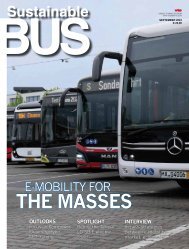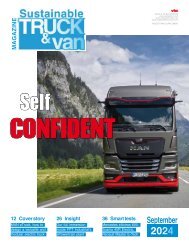2023-09 SUSTAINABLE BUS
A new issue of Sustainable Bus is out today. In this upcoming edition, we’ve curated a diverse and comprehensive range of topics that spotlight the latest developments in the world of sustainable mobility. From cutting-edge technological advancements to market insights and industry transformations, this issue promises to be a captivating exploration of the future of public transportation. What you could fine inside? Well, a market insight will offer you a detailed look at the European e-bus market, providing you with a comprehensive understanding of the mid-2023 results. The leading e-bus market in Europe is still UK: therefore, we focused our attention on that specific market with a report that sums up strategies, focus, goals of the most prominent industry players. A technology spotlight on the delicate topic of batteries, authored by Claudius Jehle, look at battery management and strategies to ensure the smooth and cost-effective operation of electric buses (with a focus on a case study from BVG). Among the pillars of our upcoming issue you’ll find a detailed journey around the European industrial bus&coach landscape. Goal? Providing our readers insights into the changing dynamics among key OEMs in the region. We’ll be then taking you behind the scenes at the Yutong factory in Zhengzhou, that we had the pleasure of visiting in June. Let’s then delve into Iveco Bus’s growing efforts in the zero-emission bus field. Finally, last but not least, a nearly-20-pages comparison between seven 12-meter battery-electric buses, gathered together in Bonn also this year by the German magazine Omnibusspiegel. You’ll find both established players and newcomers side by side: Ebusco 3.0, Hess lighTram 12m, Ikarus 120e, Iveco E-Way, Mercedes eCitaro with new batteries, Otokar e-Kent C, Quantron Cizaris 12 Ev.
A new issue of Sustainable Bus is out today. In this upcoming edition, we’ve curated a diverse and comprehensive range of topics that spotlight the latest developments in the world of sustainable mobility. From cutting-edge technological advancements to market insights and industry transformations, this issue promises to be a captivating exploration of the future of public transportation.
What you could fine inside? Well, a market insight will offer you a detailed look at the European e-bus market, providing you with a comprehensive understanding of the mid-2023 results. The leading e-bus market in Europe is still UK: therefore, we focused our attention on that specific market with a report that sums up strategies, focus, goals of the most prominent industry players.
A technology spotlight on the delicate topic of batteries, authored by Claudius Jehle, look at battery management and strategies to ensure the smooth and cost-effective operation of electric buses (with a focus on a case study from BVG).
Among the pillars of our upcoming issue you’ll find a detailed journey around the European industrial bus&coach landscape. Goal? Providing our readers insights into the changing dynamics among key OEMs in the region.
We’ll be then taking you behind the scenes at the Yutong factory in Zhengzhou, that we had the pleasure of visiting in June. Let’s then delve into Iveco Bus’s growing efforts in the zero-emission bus field.
Finally, last but not least, a nearly-20-pages comparison between seven 12-meter battery-electric buses, gathered together in Bonn also this year by the German magazine Omnibusspiegel. You’ll find both established players and newcomers side by side: Ebusco 3.0, Hess lighTram 12m, Ikarus 120e, Iveco E-Way, Mercedes eCitaro with new batteries, Otokar e-Kent C, Quantron Cizaris 12 Ev.
You also want an ePaper? Increase the reach of your titles
YUMPU automatically turns print PDFs into web optimized ePapers that Google loves.
OUTLOOKS<br />
A battery is like a flock of<br />
hundreds of single cells.<br />
Something is peculiarly<br />
different: the cells<br />
themselves. Any difference<br />
in quality or property<br />
among the flock of cells<br />
will impact the performance<br />
of the entire herd. If the<br />
asymmetry has become too<br />
pronounced, or if the BMS<br />
is unable to sense it (a huge<br />
problem of LFP), a battery<br />
can just shut down.<br />
could later become problematic, helping<br />
to sort, assess, and to find appropriate remedies<br />
- as this was the case in the BVG<br />
case study. The anomaly detection allowed<br />
the vehicle to be taken out of service<br />
and the battery system to be repaired by<br />
the manufacturer.<br />
Cost efficiency and safe and reliable ope-<br />
ration is the responsibility of the operators.<br />
Transparency, the ability to react in advance,<br />
and the capability to perform root cause<br />
analyses, will become a daily routine as<br />
the number of electric buses grows.<br />
Only with access to the basic battery signals,<br />
the above-mentioned actions can<br />
be taken. Luckily, battery and vehicle<br />
data sharing standards like VDV338 and<br />
ITxPT make their way into tenders and<br />
procurement processes, and more and<br />
more fleet management solutions and<br />
third-party providers offer simple and<br />
efficient solutions for battery health, status<br />
and quality analysis based on battery<br />
field data.<br />
Claudius Jehle<br />
www.dottotrains.com<br />
We make power<br />
last longer.<br />
100%<br />
Electric<br />
Charging<br />
forward<br />
to make zero-emission<br />
transportation work<br />
Our battery technology<br />
makes cleaner power safe<br />
and scalable.


















